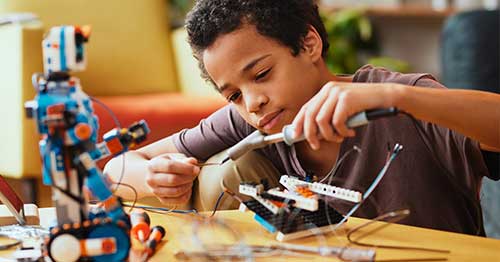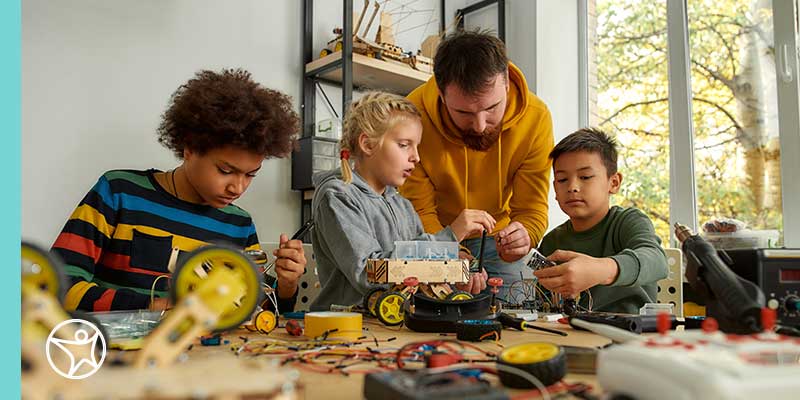7 Benefits of Setting Goals for Lifelong Success
by Valerie Kirk
byTrey Edgington
6 min to readNovember 8 is National STEM Day, but any day of the year is an ideal time to spark students’ interest in an educational experience that can not only prepare some students for their future careers but also spark their curiosity and understanding of the world around them.
STEM is an acronym that stands for Science, Technology, Engineering, and Mathematics. The term is used by educators to group together related subjects that typically help students boost critical life skills such as problem-solving, critical thinking, and abstract reasoning.
STEAM is an acronym that acknowledges the role the Arts play in Science, Technology, Engineering, and Mathematics. Rather than just adding the arts—humanities, literature, visual arts, history, and music—to STEM, STEAM explores how truly interconnected creative thought and different perspectives are to subjects people often view as cut and dry. Adding the arts to a STEM education also can give students the soft skills they may need when they enter the job market. Many educators believe STEAM is more inclusive for students who may feel out of place when pursuing STEM subjects. When students are shown how the arts help shape STEM subjects and vice versa, they are more likely to feel fully integrated with their peers as they learn.
Though STEM and STEAM are different in how the approaches are taught, they are often used interchangeably to help students learn how to apply what they are learning in school to relate to real-world application. Whether students learn STEAM or STEM, they are likely to develop curiosity to learn the necessary skills for academic, professional, and personal success.

On November 8, 2015, the first National STEM Day was celebrated to encourage and inspire young people to pursue STEM subjects.
While STEM is celebrated every day in schools around the country, families can help boost their students’ love of STEM through STEM Day activities.
The are many benefits that come from celebrating National STEM Day, including:
Increased awareness of the importance of STEM subjects
Greater interest in STEM from underrepresented groups
More businesses, schools, and other organizations collaborating to promote STEM skills
Greater opportunities for hands-on learning
Now that National STEM Day is going strong, there are a number of ways to celebrate.
Talking to students about their hobbies and interests is a great way to start a STEM conversation. As they play, get your student thinking about the various ways that STEM is a part of everything they do by asking: How are you able to ride a bike? How does your computer work? Why do musical notes sound different? How is ice cream made?
Even if you don’t already know the nuts and bolts of the whys and hows, the object of the exercise is to spark curiosity and model a habit of exploration and curiosity that can lead them to finding the answers on their own.
Hands-on learning actively engages students by encouraging them to ask questions: “What happens if…?” and “Why did it do that when I …?” Simple at-home experiments essentially wire their fast-developing brains to solve problems and find answers.
Activities that stimulate a grade schoolers curiosity include:
Build a paper airplane and see how far it flies. Then see what effect folding it a different way has on its next flight and explore possible causes.
Try to build things with small objects like jellybeans. Start sticking them together and see what kind of imaginative structures emerge. Can you make a model of a water molecule? What else?
Cut an ice cube in half with science. Ice Under Pressure uses an ice cube, a wire, and a few other kitchen items to promote kids’ scientific understanding and reasoning skills.
These do-it-yourself experiments can motivate kids to start thinking about STEM ideas and concepts, while forming a growth mindset that is critical to their educational experience.
The transition from elementary school to middle and high school can be tricky in many ways. In school, STEM subjects become more challenging. Here are ways to keep students engaged in STEM activities at home:
Creating a stop-motion video can be a fun way to play around with creativity and learn about the physics of how objects move. The best part is that stop motion can be made with nearly anything. Students can make a pattern with some LEGO bricks and take one picture at a time with a camera. Once it is done, stitch the images together to make a short film.
This staple of middle grade science becomes an effective STEM activity because it generates lively discussions about gravity and how to create a soft landing. With just an egg and whatever you have on hand, challenge your student to create a way to protect an egg from cracking as it falls from different heights. This activity can get a little messy, but students can get very creative. Let them work through trial and error as they test their hypothesis.
Some of the most famous people in history were scientists, engineers, mathematicians, and artists. From Einstein and Edison to Marie Curie and Ada Lovelace, these individuals made an impact on the world and our daily lives. Encourage your student to pick an historical figure they are interested in and create a short presentation about how their work has impacted the world today. By learning more about the people behind STEM achievements, students are more likely to see how people have used ideas that have come before them to create something new.
Computer coding may sound difficult if you’ve never tried it, but there are tons of resources, both in-person and online. that can teach coding in a fun way to students of any skill level—often with games and stories. Computer coding is a fantastic STEAM activity as it teaches both logical thinking and the creativity of creating something new.

This National STEM Day, take a minute to browse the Connections Academy® Resource Hub where you’ll find dozens of STEM activities by age and grade level.
“My 11th grader was able to take classes like 2D Animation, 3D Computer Modeling ... [and] CS Discoveries where he learned to do coding. My son also loves all of the STEM-related clubs and extra activities/events that are offered. He really gets excited to be a part of these things.”
— Connections Academy parent
To learn more about how Connections Academy tuition-free online public school can help prepare your student for a successful future, request the free eGuide or log on to join a virtual information session with educators, staff, and other parents.
